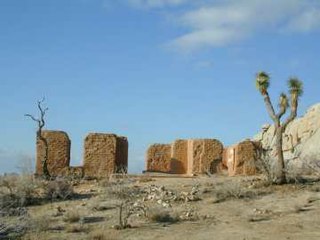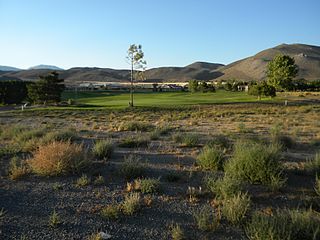
Cherry County is a county located in the U.S. state of Nebraska. As of the 2020 United States Census, the population was 5,455. Its county seat is Valentine. The county was named for Lt. Samuel A. Cherry, an Army officer who was stationed at Fort Niobrara and who had been killed in South Dakota in 1881. Cherry County is in the Nebraska Sandhills. It is the largest county in the state at nearly 6,000 square miles (16,000 km2), larger than the state of Connecticut.

Theodore Roosevelt National Park is an American national park of the badlands in western North Dakota comprising three geographically separated areas. Honoring U.S. President Theodore Roosevelt, it is the only American national park named directly after a single person.

Lyndon B. Johnson National Historical Park is a United States National Historical Park in central Texas about 50 miles (80 km) west of Austin in the Texas Hill Country. The park protects the birthplace, home, ranch, and grave of Lyndon B. Johnson, 36th president of the United States. During Johnson's administration, the LBJ Ranch was known as the Texas White House because the President spent approximately 20% of his time in office there.
Camp Nichols, also known as Fort Nichols or Camp Nichols Ranch, was a short-lived historic fortification located in present-day Cimarron County, Oklahoma, about 3 miles (4.8 km) northwest of the community of Wheeless, Oklahoma. It was built by New Mexico and California volunteers under the command of Col. Kit Carson to protect travelers on the most dangerous part of the Cimarron Cut-off of the Santa Fe Trail from raids by the Kiowa and Comanche Indians. Established in May 1865 and abandoned in September 1865, it was the only human-made structure along the Cimarron Cut-off while it was an active route. It is believed to have been named for Captain Charles P. Nichols of the First California Cavalry.

The King Iron Bridge & Manufacturing Company was a late-19th-century bridge building company located in Cleveland, Ohio. It was founded by Zenas King (1818–1892) in 1858 and subsequently managed by his sons, James A. King and Harry W. King and then his grandson, Norman C. King, until the mid-1920s. Many of the bridges built by the company were used during America's expansion west in the late 19th century and early 20th century, and some of these bridges are still standing today.

The Ryan House and Lost Horse Well are historic ruins in Joshua Tree National Park, California, United States. It was established by the family of J.D. Ryan, the later developers of the Lost Horse Mine, which became the most profitable mine in the area. The Lost Horse Well at the Ryan Ranch supplied water to the Lost Horse Mine, 3 miles (5 km) south and 750 feet (230 m), by pipeline.

The Rawhide Buttes Stage Station, the Running Water Stage Station and the Cheyenne–Black Hills Stage Route comprise a historic district that commemorates the stage coach route between Cheyenne, Wyoming, and Deadwood, South Dakota. The route operated beginning in 1876, during the height of the Black Hills Gold Rush, and was replaced in 1887 by a railroad.
The Fort Laramie Three-Mile Hog Ranch was built to serve as a social center away from the soldiers' post at historic Fort Laramie. Fort Laramie was a 19th-century military post in eastern Wyoming. It became notorious as a place for gambling and drinking, and for prostitution, with at least ten prostitutes always in residence. The location is notable as an example of one of only a few military bordellos still standing in the United States by 1974, the time of its nomination to the National Register of Historic Places The Fort Laramie site was one of a number of so-called "hog ranches" that appeared along trails in Wyoming.
H-T Ranch is a historic ranch complex 10 miles (16 km) west of Amidon, North Dakota. The ranch originally consisted of ten buildings; however, only the ranch house and log barn survive. The ranch served as the headquarters of the Little Missouri Cattle Company, which was run by Arthur Clark Hidekoper. Hidekober established the ranch in the 1880s, and by the end of the decade, it had become the "most notable" ranch in the area. The ranch house, called Shackford, was built in 1896; its uncommon style resembles a bungalow but also borrows from other styles such as the Stick style. By 1906, the Fargo Forum described the ranch as "the biggest and most important [ranch] in the state" and "one of the largest horse raising outlets in the world". In the same year, Hidekoper sold the 70,000-acre (28,000 ha) ranch; the sale was the largest land deal in North Dakota history. After the sale, a land company reduced the ranch to 5,000 acres (2,000 ha); it was later used as a dude ranch in the 1920s.

The Elkhorn Ranch was established by Theodore Roosevelt on the banks of the Little Missouri River 35 miles north of Medora, North Dakota in the summer of 1884. Roosevelt hired Bill Sewall and Wilmot Dow, two Maine woodsmen, to run the ranch. Sewall and Dow built the ranch house, "a long, low house of logs," in the winter of 1884–1885.

The James Cant Ranch is a pioneer ranch complex in Grant County in eastern Oregon, United States. The ranch is located on both sides of the John Day River in the John Day Fossil Beds National Monument. The ranch was originally homesteaded by Floyd Officer in 1890. Officer sold the property to James Cant in 1910. Cant increased the size of the property and built a modern ranch complex on the west bank of the river. The National Park Service bought the ranch from the Cant family in 1975, and incorporated the property into the John Day Fossil Beds National Monument. The National Park Service used the main house as a visitor center until 2003. Today, the Cant Ranch complex is preserved as an interpretive site showing visitors an early 20th-century livestock ranch. The James Cant Ranch is listed on the National Register of Historic Places.

The Sod House Ranch is a historic ranch in Harney County in southeastern Oregon, United States. The remaining ranch structures are located south of Malheur Lake in the Malheur National Wildlife Refuge. The ranch was built by Peter French, a well known 19th-century cattle baron. The Sod House Ranch became the headquarters for the northern operating division of the French-Glenn Livestock Company, which eventually covered over 140,000 acres (570 km2). After French was murdered in 1897, the French-Glenn Livestock Company slowly sold off its ranch property. In 1935, the United States Government purchased the Sod House Ranch property to add to an adjacent wildlife refuge. The eight remaining Sod House Ranch buildings are now listed on the National Register of Historic Places.

Peaceful Valley Ranch is about 3 miles (4.8 km) from the town of Medora, North Dakota in the South Unit of Theodore Roosevelt National Park, in western North Dakota. The ranch dates from 1885, when Benjamin Lamb bought the land and built its first buildings. After operating as a ranch, primarily raising horses, the ranch was developed by the Olsen family as a dude ranch before it was acquired by the National Park Service, and incorporated into the Roosevelt Recreation Demonstration Area, which eventually became the present national park. The ranch forms the core of the national park's South Unit. It overlooks the Little Missouri River, in the Little Missouri badlands.

The Raycraft Ranch, located north of Carson City, Nevada on U. S. 395 was listed on the National Register of Historic Places in 1976. It has significance for being the site of the first airplane flight in Nevada, on June 23, 1910. The listing included 334.2 acres (135.2 ha) with two contributing buildings and one other contributing structure.
The Capa Bridge is a historic bridge in rural Jones County, South Dakota. It is located 15.7 miles (25.3 km) west and 9.8 miles (15.8 km) north of Murdo, and about 3 miles (4.8 km) east of Capa, and carries a local road over the Bad River. Its main span is a Pratt through truss 127 feet (39 m) in length, which has been riveted rather than pinned together. The bridge also has five smaller approach spans on the west and two on the east, made of wooden stringers. The bridge piers are either concrete or wood pile, and the outermost abutments are wood pile. The bridge was apparently built in 1919 by a county crew, and is one of only two pre-1920 bridges in the state to use a riveted Pratt truss.
Axel Johnson Ranch, on Sorum Road about 3 miles (4.8 km) east of South Dakota Highway 79, about 9 miles (14 km) south of Reva, South Dakota, was listed on the National Register of Historic Places in 1987. The listing included five contributing buildings and two contributing structures.
The Cold Springs Ranch House near Forsyth, Montana is a log house built in 1908. It was listed on the National Register of Historic Places in 1990.
The John and Daisy May Livingston Ranch, in Harding County, South Dakota near Sorum, South Dakota, was listed on the National Register of Historic Places in 1987. The part of the ranch which was listed included two contributing buildings and eight non-contributing ones on 4 acres (1.6 ha). It includes a house built in 1916.
The Giannonatti Ranch, in Harding County, South Dakota near Ludlow, includes 10 structures dating from around 1900. A 2 acres (0.81 ha) portion of the ranch was listed on the National Register of Historic Places in 1987.
The Thomas Ashcroft Ranch, in Harding County, South Dakota near Buffalo was listed on the National Register of Historic Places in 1987.












